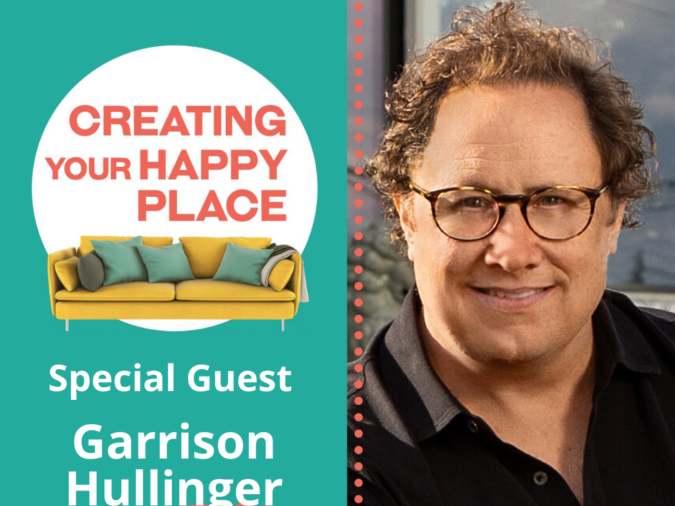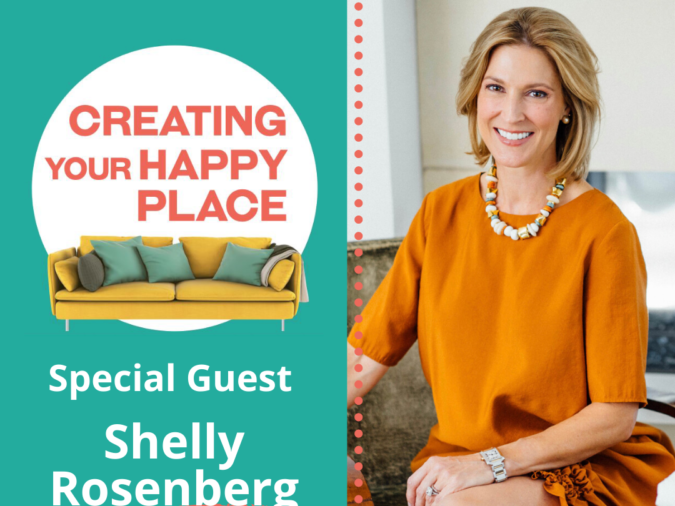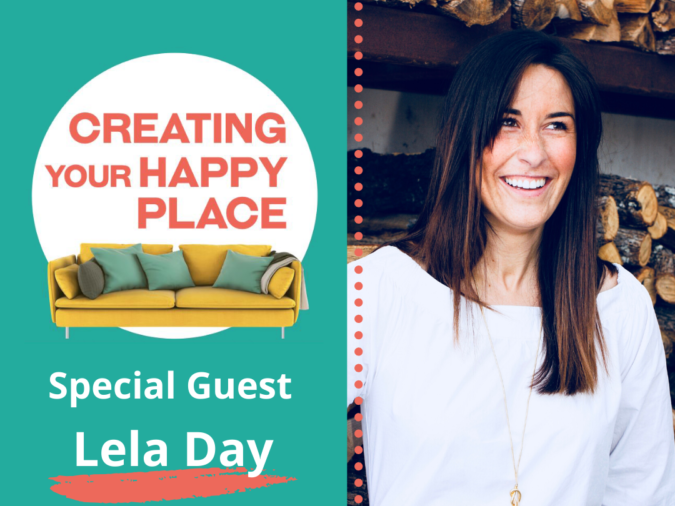CYHP Podcast: Moving On Without Moving Out
CYHP Podcast: Moving On Without Moving Out
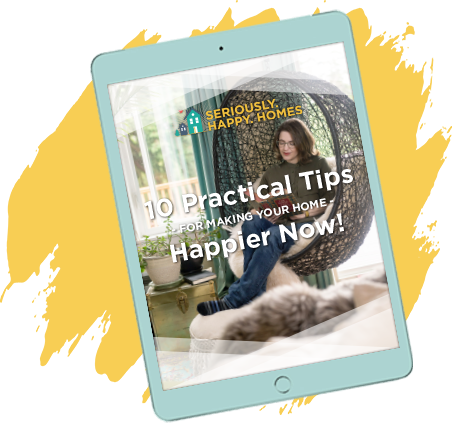
Eager to get happy at home right now?
Get 10 tips for a happier home!
Welcome to Creating Your Happy Place! A podcast that explores how our spaces support (or sabotage) our happiness and make it easier (or harder) to reach our goals, then empowers you to do whatever it takes to get happy at home. 😊🏡
If you would rather read the episode than listen, we have provided a full transcription of the episode below. Enjoy!
![]()
Welcome to Creating Your Happy Place. A podcast that explores how our spaces support or sabotage our goals and our happiness, and then empowers you to do whatever it takes to get happy at home. I’m Rebecca West, host of Creating Your Happy Place and author of the book Happy Starts at Home. And I’m so glad you’ve joined me here today.
Today’s episode of Creating Your Happy Place is the very first episode ever. So my job is to tell you a little bit about myself, how this podcast came to be and what to expect from future podcasts. In case you decide to join in, in future episodes. So let’s start with where it all began. Thirteen years ago, I started a career in interior design, but it wasn’t on purpose. I got a divorce. And if you’ve gotten a divorce, you can identify with the fact that, well, your entire life falls apart.
And then you have to pick up the pieces and create something new. So what did that look like for me? OK. Well, my ex-husband moved out of the house. I got to keep the house, which was a blessing. But he didn’t take all the memories with him. Right. So there I was living in this house, which again was a good thing. But I was staring at all of the artifacts of my marriage.
There was the bed we shared, there was the paint colors we had chosen, there was the sofa that we’d gotten through his parents and coming home or being home just felt awful. Like every time I walked past the sofa, it was like somebody whispering to you, “You make bad decisions”, right? Because I kind of had failed at the biggest thing I thought I was ever going to do in my whole life. Right. Partnering with another human being.
And I can’t tell you exactly what made the light bulb go off in my head. But one day I decided I cannot keep living like this. I got some old paint out of the garage and I started painting. And I started by painting my ceilings, my vaulted ceilings. Mind you, black. This was a horrible design decision because it looked really terrible. Imagine vaulted ceilings painted black. Along with the already existing lime green accent wall. And then to add insult to injury, I painted another accent wall in a faux finish with a bright turquoise paint.
It was a hot mess. So while it was a bad design decision, it was actually a fantastic life decision because it looked so bad that I had to fix it. And in having to fix it, that kind of gave me permission to do so intentionally. It made me think through, well, what kind of space do I want to live in? What kind of space would make me feel happy? What kind of space would feel like me?
So I then bought paint on purpose. I bought beautiful paints and like pale pinks and sea glass greens and gentle lavenders. And I created this gentle cocoon, this feminine cocoon in which I could heal in my own home. That lit a fire under me that created momentum. I started selling all that old furniture on Craigslist. There went the bed. There went the sofa.
And I bought all, quote unquote, “new”, new to me furniture on Craigslist stuff that would just be about me now and me in the future. One of my favorite pieces was this turquoise velvet couch. And it was well, let me put it this way. It was ten dollars. It didn’t even have feet. There were some burn marks in it from someone else’s cigarettes, like, you know. That doesn’t sound very awesome or romantic, but I loved it because I’d always wanted a turquoise velvet sofa and on a divorced woman’s budget, this was just the right price tag. And I added some feet and I loved the heck out of that thing. So I repainted the space with intention after the angry phase with the black painted ceilings. I got rid of the furniture that kind of made me feel like a failure that anchored me to that old story. And I got new furniture that kind of gave me a glimpse of the future.
And it was so transformative that I went, oh my gosh, this thing called interior design that I’d never taken seriously. I just thought it was throw pillows for rich people. This thing called interior design could actually be helpful. I mean, it had just helped me go from feeling miserable in my space and really hopeless, feeling like I’m never going to love again and never going to have a future, to feeling hopeful! Like, “All right. Well, if I can change my physical surroundings, maybe I can change my emotional situation.”
Maybe there was hope for me after all. And if you’ve come out of a divorce or if you haven’t been with it, it might sound a little silly, like, oh, you’re never gonna find love again. But when you’re in the middle of it, that’s exactly what it feels like. You’re either never going to find love again or you refuse to find love again. And I’ll admit that the new bed that I bought for myself was a twin bed.
It was a bed for one person. Nobody else was invited. Because in the moment of trauma, you can’t really imagine a future. What I was trying to do by redoing my space was at least imagine a present that wasn’t so tied to my past. So I went through this transformation and I was career and marriage free, because I had stopped working at my previous career path, which was teaching ballroom dance. And I went, “Well, I’m not doing anything else.
I’m gonna help other people do what I just did. I’m going to help them transform their spaces so that they can feel happy at home, too.” And I was only going to do redesign and color consults because that was the talent set I had. I was gifted a talent with color and redesign, which is really just taking the things that people already own and then helping them use them better. rearrange them. Which was something that came really naturally to me because I grew up in the military and we moved a lot.
And so, you know, every few years we would take all of our belongings and set them up fresh in a new home. And within two weeks we had everything unpacked. I thought that’s how everybody lived. Turns out that’s actually not normal. But we had everything unpacked and always felt like we were home, even though the house, the physical house we were living in and the geography, the city we living in had changed. So I was justfully-fledged going to take those skills and help people transform their spaces.
Fast forward 13 years and here I am with a fully fledged interior design company and we’re doing kitchen and bath remodel designs, things that I never imagined. And I have a staff. That it all started from that place of transforming my physical environment from one that was making me feel miserable and sabotaging my happiness to, you know, I didn’t move. I moved on without moving out. Taking that same physical environment and turning it into one that supported my future and made me able to see possibility and hope.
And that’s what has always underpinned my reason for being an interior designer in the first place. It’s still, for me, not about throw pillows for rich people.
It’s just about making sure that no matter what your budget, what your status in life, that your home environment is making you as happy as possible and helping you achieve the goals that you want to achieve. So that’s why about six years after I started the company, I wrote my book, Happy Starts at Home, and it’s filled with exercises that are meant to take you on that same journey. Right? Think about your space as one that can either help you achieve the goals that you have for your life or be aware of how it’s being an obstacle, how it’s getting in the way of those goals that you have for your life.
So that’s what the book is meant to do. Happy Starts at Home. And now fast forward another many years. And I’m here to do this on a new platform. I want to have a more intimate conversation with you. And I want to not only explore my story and, you know, the divorce, how I recreated that space, but also how I then had to reinvent my living situation again when I got remarried to my new husband and we had to recombine spaces as adults.
You know, that’s a whole nother transformation of taking something that in that case, I was very happy with. I was very happy with my single woman’s home. And how do I then leave that and create a space for two people that reflects both of us and our new story. So I want to have a conversation with you about my story, about your story. But most excitingly, I’m going to be bringing in guests who have also done the same thing.
They’ve taken the obstacles that life gives to all of us, and they’ve turned those lemons into lemonade. And specifically, they’ve done it in their home environments. They’ve thought about how does my home affect me? How do I need my home to work for me? Maybe they’ve gone through patches of time where their home wasn’t working for them. What were the obstacles that kept them from creating a happy home? What were the rules they were living by that they thought were true, that maybe weren’t true?
Because I want these stories and some of them are going to be about people that have seemingly insurmountable obstacles. I want you to hear these stories and then I want you to turn that around and help you think about your own obstacles in your own life, in your own home, and think, how can I change the situation so that I also am happy in my home? How can I change my situation so that my home is supporting the things I want from my life that’s supporting the goals that I have set for myself.
And, you know, at least as importantly, is not putting up obstacles and barriers to the goals and things that I want for my life.
And then we’re also going to have a little bit of fun on this podcast, talking to people who live in alternative living situations, people who might live in tree houses or out of ex-patsRV’s or who are expats, maybe people who live in the military and don’t actually get to spend all that much time in their actual home. People who have gone through empty nesting or maybe who are living in assisted living or live in co-ops or have their grown children living with them again.
There are so many ways that we can define what being home looks like and what it means. But in the end, I want all of us to be happy at home. That’s what I want this podcast to do for everybody who’s listening. So if this catches your attention and if you want to be part of this journey, I’m so happy to hear it. And that means, of course, that you need to do all things that happen with a podcast, you should like it.
You should subscribe to it. You should share it and tell other people about it. Maybe most importantly, you should leave a review because reviews are how other people find new podcasts. And then, of course, don’t hesitate to reach out to me if you have obstacles that you’re facing and you want me to address those obstacles in a future episode. Or if you know of somebody who has turned obstacles into opportunities as it relates to our home environments or somebody who has a story to share that you think really gives a new perspective on this conversation about our spaces and how they support or sabotage us.
Please reach out and let me know.
But that’s it for the first episode. I hope you’ve enjoyed it. And I hope this short conversation has left you feeling a little bit more encouraged as you think about your own happy environment. And of course, if you’re stuck. I’m going to recommend that you do check out my book- Happy Starts at Home. It’s available on Amazon as well as through many indie booksellers. And we’ll have the link to that in the show notes. And if you’re facing a specific design dilemma, you can also reach out to my team at my company, Seriously Happy Homes, because thanks to the power of the Internet and the magic of the Internet, we can help you wherever you call home.
Through our Design Helplines, you can have 30 minutes on a Zoom call with a professional interior designer to talk through a design dilemma that you’re facing.
But in the meantime, that’s it for Episode one. And this is Rebecca West signing off from Creating Your Happy Place. And I just hope that your home makes you seriously happy. Bye for now!
MAY YOUR HOME ALWAYS BE HAPPY!

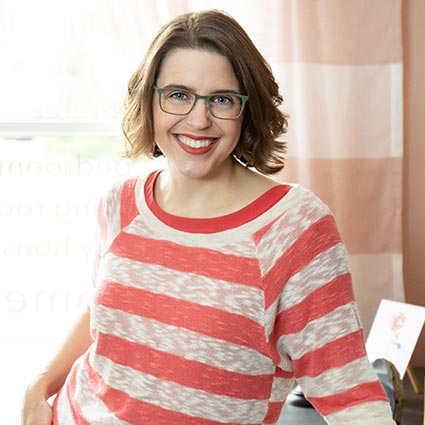
HI, I'M REBECCA WEST!
I’m an interior designer, author, podcaster, speaker, and coach to other designers. (Whew!) But I’m not your classic interior designer because, frankly, I don’t care if you buy a new sofa. I do care if your home supports your goals and feels like “you.” Remember, happy starts at home!
More From Seriously Happy Homes
Are you ready for a seriously happy home?
(Cue the confetti!)

Eager to get happy at home right now?

